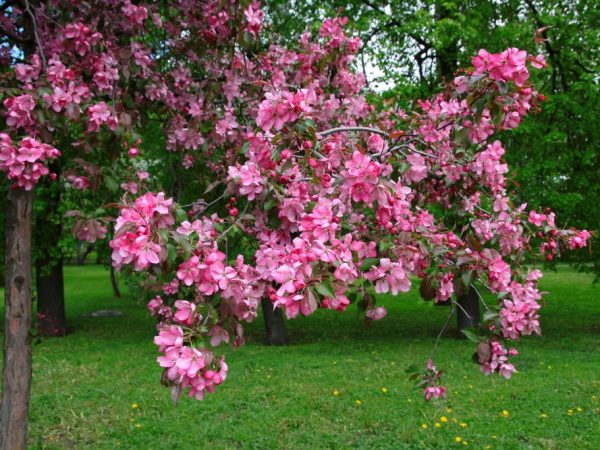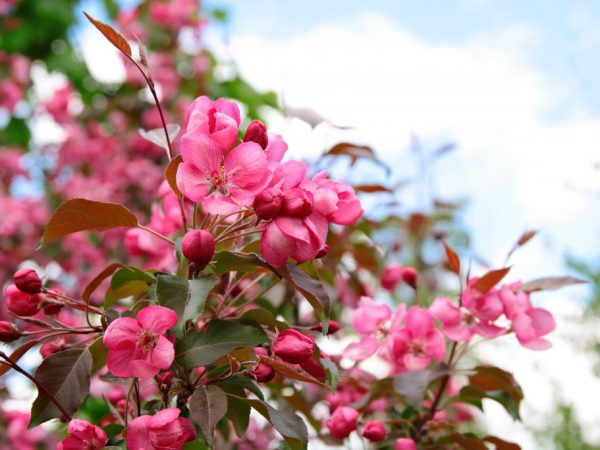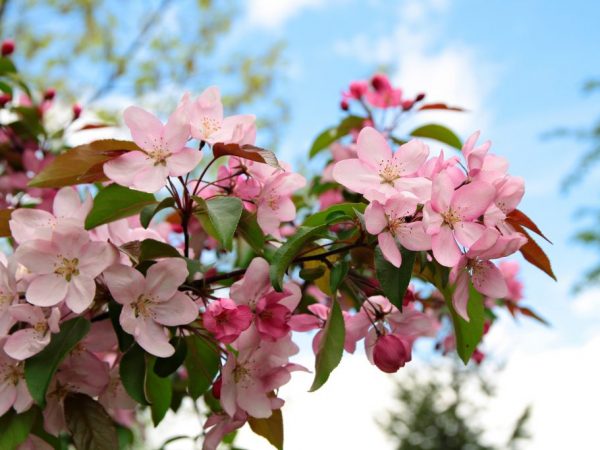Varietal characteristics of the Nedzvetsky apple tree
The apple tree of Nedzwiecki got its name from a famous botanist who discovered this unusual tree while traveling in Asia. Varieties of this variety soon became popular throughout Europe.
- Apple tree characteristics
- Taste
- Winter hardiness
- Disease and pest resistance
- Use in landscape design
- Growing regions
- Landing
- Care rules
- Pruning and shaping the crown
- Preparing for winter
- Protection against diseases and pests
- Reproduction
- Features of ripening and fruiting
- Harvesting and storage
- Subspecies and variants
- Gardeners reviews

Varietal characteristics of the Nedzvetsky apple tree
Apple tree characteristics
The main advantages of the variety include the external attractiveness of the tree itself. In addition, the apple tree has the following advantages:
- high resistance to temperature extremes;
- ease of care;
- rapid growth and development;
- ease of adaptation to the terrain.
The decorative tree has practically no flaws. The most significant disadvantages are the small height of the apple tree and the sour taste of the fruit.
Description of the tree and fruit:
- the apple tree is medium-sized, has a massive trunk and gray bark. Without being pruned, it has a tent-like or round crown. The branches of the seedling during the period of active growth are distinguished by a dark purple color;
- ovoid leaves with a pointed tip and jagged edges;
- flowers of this species are distinguished by their unusual appearance. After blooming, they take on a bright pink hue. One inflorescence can consist of several buds;
- the diameter of the fruits can be 2 cm, they have a spherical shape. Apples are also dark red or purple-purple in color. They have pink flesh, in one fruit - up to 9 seeds.
The ornamental apple tree is capable of reaching the age of 60 years.
Taste
The apple tree of Nedzwiecki is also distinguished by the taste of its fruits. Fruits in the period of biological ripeness are sour with notes of sweetness. The structure of the pulp is dense, bright white.
Winter hardiness
The apple tree tolerates severe frosts well. In winter, it can withstand temperatures as low as -30 ° C.
Disease and pest resistance
Like all similar varieties, the apple tree has good resistance to various diseases and pests.
However, if the rules of agricultural technology are violated, the tree may be exposed to ticks, scabbard, glass or aphids. In this case, it should be treated with chemicals.
Use in landscape design

Apple tree will decorate your garden
Due to its unusual appearance, beautiful leaves and fruits, the apple tree will harmoniously fit into the composition of a garden or lawn. Since these trees are unpretentious to maintain, they are often used in landscape design.
These apple trees can also be grown as part of a Japanese garden. They are not only a decoration of the territory, but are also considered good pollinators. Planting the variety will contribute to a good harvest throughout the garden.
The apple tree is often used in the formation of garden compositions. Also in landscape design, it is used to create a living fence due to its bright color.The crown of this tree allows you to create a variety of garden shapes.
Growing regions
Today, the ornamental apple tree of Nedzwiecki is grown in many regions. The most favorable conditions for this are the Moscow region. Due to their good winter hardiness, trees take root in the Leningrad region.
Ukraine is also a favorable territory for sowing the variety. Mild winters in most regions of this country ensure that trees of this species do not suffer from cold weather. They take root well both in Siberia and in the Urals under conditions of cultivation in a windless area.
Landing
The description of planting seedlings has several nuances. First of all, you should know that it is produced in early spring or autumn. In colder regions, it is best to sow the crop in early spring. In this case, the seedlings will take root well and overwinter.
For planting, you should choose a well-lit place, groundwater should be located at a distance of at least 2 m from the surface. It should be noted that the crown of an adult apple tree will become quite extensive when it grows.
The planting pit is prepared in 2 weeks. In this case, the soil must have time to settle. The pit should have dimensions of 70x70x80 cm. After the hole is dug, it is filled with humus, garden soil or river sand. Ash can also be added.
To plant, a peg should be driven into the center of the pit, and a seedling should be tied to it, given that the root collar should be at ground level. Before planting a tree, you should carefully spread its roots, then sprinkle them with earth.
After that, the seedling needs to be watered with two or three buckets of water. Next, you should form a circle around the trunk and sprinkle it with mulch. When planting, do not place too many trees nearby. If you provide them with more free space, they will be less susceptible to various diseases.
In addition, such a planting will help preserve the beauty of the garden design. Ornamental varieties take root best during autumn planting. In this case, the tree takes root tightly before the arrival of winter, grows and develops well.
Care rules

Water the plant once a month.
Caring for a tree includes several rules. First of all, you need to water once a month. About 4 buckets of water are poured under the seedling. In the hot season, water the apple tree more often.
The main hydration is performed during these periods:
- after the end of winter;
- after the flowers bloom;
- one month before harvest;
- during preparation for winter.
Approximately 2-3 years after planting, you should start feeding. During the main watering in the spring, you need to add mineral fertilizers and organic matter. The latter can consist of chicken droppings or manure.
Chemical fertilizers are added at the beginning of the summer period. Subsequent feeding is done at the end of August and in October. In the fall, during the digging of the soil, various fertilizers are also applied, for example, humus.
Pruning and shaping the crown
Pruning can be done two years after planting. Basically, the formation of the crown occurs in the spring. During pruning, old, broken, dried branches are removed.
Also cut off the branches that grow inside the crown. The ends are trimmed one third of the length. A tree over 10 years old is pruned to restore active growth of new branches.
Preparing for winter
Leaving also means preparing for the winter period. For this, the roots of the apple tree are covered with leaves, and then with earth. It is also necessary to remove peat and dry branches, otherwise the root may rot.
Protection against diseases and pests
To prevent diseases and pests, special preparations should be used. To get rid of insects, insecticidal agents are used - "Ekoberin", "Zircon".
The tree is protected from hares by tying it with burlap.They dig up the earth around it, and then lay out spruce branches from pine or spruce, adding dry peat, humus.
Also, to protect against diseases, Nedzvetsky's apple tree is whitewashed. The seedling should be covered with a chalk solution, an adult tree with lime.
Reproduction

The tree needs good care
The most common method is seed propagation. They are planted in the autumn. Before this, the seeds are stratified. This can be done by placing them in a damp cloth and then in this form in the refrigerator.
After 2 months, the seeds are disinfected with a solution and sown into the formed soil. After germination, the sprouts are transplanted into a well-lit area. Then the seedlings will need good care and insulation before frost.
Features of ripening and fruiting
The tree ripens towards the end of May, after the leaves appear. Flowering can last up to 14 days. However, this period may vary depending on growing conditions.
Flowering may not come or may be delayed. This happens in several cases. First of all, because of the age of the seedling, then you just have to wait. In addition, overly fertile soil can contribute to the lack of flowering. Damage due to severe frost can also be one of the reasons for this.
Harvesting and storage
Fruits are harvested at the end of September. Unlike other fruit crops, the apples of the variety do not fall to the ground and can remain on the branches throughout the winter. Frozen fruits are considered tastier.
The harvested fruits can be stored dried. So they perfectly save vitamins. In addition, apples are great for making jam, cider. Jam and compotes are also made from the fruits.
Subspecies and variants
The Nedzvetsky apple variety has many subspecies and variants. The most common is the Royalty apple tree. This species is distinguished by its beauty during flowering. Therefore, it is widely used in landscape design.
In appearance, the Royalties are similar to cherry blossoms. The variety has a crown densely covered with flowers. They are distinguished by ruby and crimson hues. Flowering occurs towards the end of spring. The fruits of the subspecies are inedible. The height of the tree can reach about 4 m.
The red-leaved subspecies has a decorative crown. The height of the tree can reach 10 m. Such apple trees have a fairly abundant flowering. The flowers are fragrant, light pink.
The weeping apple tree grows up to 12 m. It tolerates sub-zero temperatures well. Quite often used in garden design. Most often planted in the area of water bodies.
Wild is also one of the subspecies. Reaches a height of 5-6 m. Has a brown bark. The flowers have a bright pink hue. The flowering period is 10 days and occurs towards the end of spring. After ripening, the fruits become purple and waxy.
Gardeners reviews
Reviews of experienced gardeners about this variety are positive. These trees are mainly used for landscape design. The use of fruits in cooking allows you to make jams, compotes from them. You can also dry apples.
In order for the tree to grow and develop intensively, as well as to give good yields, it should be provided with the necessary care. In this case, the Nedzwiecki apple tree will delight you with a beautiful appearance and good fruits. The price of this variety, according to gardeners, is quite acceptable.

